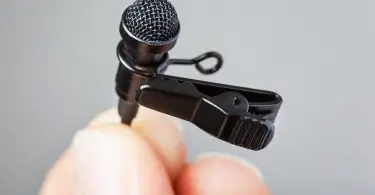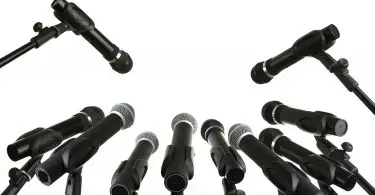Finding the right system for your instrument is vital to a good live performance. To find yourself in the middle of a gig with a malfunctioning system would cause an onslaught of despair for your audience.
Choosing the incorrect system could yield a lack of quality in your audio playback, an incoherent signal, a lack of dynamic range, and a lack of necessary tools to utilize any audio processing capabilities you need for your records. Although there are many different wireless instrument systems, we will focus on guitar systems in this article.
Top Pick: Line 6 Relay

A profusion of features for a fraction of the price, the G75 is a great wireless system. This system even maintains the ability to incorporate foot pedals into your arsenal of audio processing.
Note: the information presented in this article can be applied to most types of instrument systems. Therefore, it is possible to use this as a guide if you play a different instrument.
Why Trust Us?
I am currently a student studying to acquire a bachelor’s of science in audio technology and computer science at the best school for audio production in the United States I have been playing shows as a musician for almost ten years as a drummer, guitarist, and bassist.
As a student, I have worked towards creating the schematics for different loudspeaker and microphone systems. And I am currently working on a digital audio signal processing software that compresses an audio signal. I have worked on projects where the goal was to create a MIDI instrument that responds to bodily movement.
Finally, I have worked in a state-of-the-art studio recording, mixing, mastering, and producing various artists and groups for the past two years. Although I have not directly worked in the creation of a wireless instrument system, I understand the properties and fundamentals that separate a great system from an unreliable one.
What Is A Wireless Instrument System?
As technology has evolved, the expectations an audience holds for a performer has increased dramatically. Due to these, mobility and agility are more important than ever in the musicians live performance. Out of this necessity came the invention of the wireless system.
The instrument systems work to render any instrument cables unnecessary. Due to the unnecessary nature of a wired system, musicians have the ability to move freely on stage, into the crowd, etc.
Unfortunately, the biggest limitation for these systems is distance and integrity. Alternatively, there are different specifications that will inform you on the reliability and ability of these systems.
How Do These Systems Operate?
Wireless instrumentation systems work through an audio property known as frequency modulation. The principle of frequency modulation can be understood relatively easily if you watch many ’80s portrayals of a
mad scientist’s lab.The principle is relatively diminished in the example I linked above, however, the main idea is that there are two (or more) frequencies mixed with another bare signal source that creates a fluctuation of sound summing to different amounts depending on the base frequencies.
Fortunately, you do not need to understand the complex mathematics behind frequency modulation to utilize a wireless system, but it is helpful to understand this in order to understand how it works.
The two methods in which frequency modulation is used for these systems is based on very high frequency(VHF) and ultra high frequency(UHF) bands. Many audiophiles will explicitly tell you that a VHF system is inferior to an ultra high-frequency system. However, each system has their positives and negatives.
UHF
Unfortunately, the audio industry has seen a steep drop in the UHF systems. However, this does not mean they are useful for a certain category of musicians. Due to the incredibly high frequency they utilize, UHF systems are very good for decreasing the possibility of interference with other systems.
This inadvertently means that you will have less need for troubleshooting and you should be able to move further from the system. However, the necessity to reach higher frequencies induces higher production costs due to expensive parts, assembly, and work by engineers. These costs tend to fall on the consumer.
VHF
VHF systems, on the other hand, are not falling out of popularity. In fact, due to the supply and demand increasing in recent years, the availability of VHF systems is nearly worldwide. A VHF system is great for the touring musician. In contrast to the UHF system, a VHF system will last a quarter to twice as long as a UHF system.
The lesser cost of the VHF system and the longer life of the VHF system have led manufacturers and musicians alike to begin purchasing and utilizing VHF systems in droves.
Frequency Hopping
Frequency hopping can refer to an assortment of things. It generally refers to the transmission frequency in which a signal is using to reach the playback system or your instrument. This term will take on a variety of names, the most popular being frequency hopping and digital transmission frequency.
In recent years, the most popular wireless systems have begun using a frequency of 2.4 GHz. This is a frequency that was granted by many countries including the United States as a license-free domain for the audio industry. This primarily means that it is free to use this frequency for wireless systems if they are used as an instrument frequency (which is probably why many top companies have begun to utilize it).
Another aspect of frequency hopping must be mentioned for digital wireless systems. Much like your phone, in order to speak or transmit audio through a wireless medium, you must have an assortment of available frequencies at your disposal.
To diminish the possibility of interference, many systems utilize the frequencies between 900MHz and 2.4GHz to transmit audio. Systems that implement this feature will usually be more reliable than the competition that does not.
The Most Important Feature
The most important feature of a wireless system is its ability to detect possible interference scenarios and avoid them, this property is called frequency agility. As mentioned in the previous paragraph, many companies will integrate a variety of different possible frequencies into their system. This is a great idea.
However, the implementation and smooth transition between frequencies will determine the difference between a good system and a great system. After all, losing your control over the crowd because of a system malfunction is probably the worst scenario for any musician.
As with most features, the drawback to buying a system with great frequency agility comes with the price. Due to the relatively unstable and unforeseeable nature of frequency modulated airwaves, having a fixed-frequency system should not be a part of the agenda for any touring musician or performer.
The best way to understand the quality of frequency agility is based on the assorted options you have. The option of having five different frequencies can be great for a comedian, or a one-man-band. However, if you are a touring group with upwards of four to eight members, you will need a wide assortment of frequencies.
Luckily, there are systems that can give you thousands of different options, and for the groups with a lesser number of members, the frequency options can be limited.
A final note on frequency agility: There are systems that include scanners. As the name suggests, these systems will scan for frequencies with minimal to no activity and automatically adjust. These can be useful for large touring acts and are often used by world famous musicians.
Best Practices: Antenna
As you can tell by the nature of this article, the wireless features of these systems pose many possible problems but are also the reason we purchase systems like these. A huge problem that was born out of wireless systems has become the interference of systems with other wireless systems.
This is due to the previously mentioned properties as well as a minimal ability to discriminate between signals. Fortunately, newer technology has come out, known as true diversity. True diversity integrates discrimination into the wireless system.
Your audio signal should theoretically be the strongest signal that your system can attract. Due to this principle, a system that integrates true diversity into the circuitry will only accept the most powerful signal in its range. These systems will usually be equipped with two antennas on either side of the system.
Best Practices: In General
Before mentioning the best wireless systems on the market, I want to give some tips concerning the best practices when utilizing these systems. With every system, you will have a receiver and an antenna.
If possible, always ensure your antennas are engaged and in the upright position and make sure you (or the receiver) are always in visual distance of the antenna. By implementing these two practices, you will have the best possibilities of ensuring great audio playback and minimal interference.
A Note On Wireless Microphones: Wireless microphones are a slave to all of these principles as well as the same principles that make up a great wired microphone. For these reasons, you should check out our post on what makes a great condenser microphone.
The Competition
After hours of testing and research, here's the final competition.
| Instrument | Rating | Current Pricing |
|---|---|---|
Line 6 Relay G75 | Best wireless system on the market today |  |
Audio-Technica ATW-801/G-T8 | Great companion for the touring musician because it is durable |  |
Nady U-1100 GT | Inherently makes the signal ability of this system stronger |  |
Shure GLXD16 | Smooth integration of guitar pedal features |  |
Xvive U2 | Singular wireless system that operates on 2.4GHz frequencies |  |
Shure PGXD14 | Great gigging system as it provides 16 hours of battery life |  |
The Best Wireless Guitar System: Line 6 Relay G75

Credit: Line 6, Inc.
As mentioned at the beginning of this article, the Line 6 Relay G75 is the best wireless system on the market today. I can personally attest to the magnificent abilities of this microphone. As a younger musician, I played over 40 gigs through the whole east coast of the United States with little to no problems with the G75.
The only problem I had was the need to charge it after a week worth of 30 minutes to one hour long gigs. However, this is mentioned in the specifications of the G75 (eight hours of usable battery life and 50 hours of standby time).
The G75 is a great wireless system by Line 6, who is known in the guitar community as a great system provider. Although the G75 does not provide a great portfolio concerning frequency agility, the primary frequency on this system is 2.4 GHz. In an effort to combat this drawback, Line 6 integrated quad-antenna array and dual receiver technology. By this definition, we can assume that there is some form of true diversity.
When integrating these features, the main objective is to increase transmitter/receiver integrity and decrease the amount of dropouts. The system also has a built-in switch that is capable of switching between multiple transmitters which make this one of the best gigging systems.
For different venues, some band members may want to be on a given side. The ability to choose who utilizes the wireless system encourages freedom among the musicians.
Integral to most guitarists, the line G75 maintains the ability to incorporate foot pedals into your arsenal of audio processing. This feature is found in many higher end wireless transmitters, yet the G75 is available for one-half to a fourth of the price of most higher end units (Current Amazon.com price: 
In summary, the Line 6 G75 is a great wireless guitar system for most road musicians due to its versatility, its ability to work for many nights without changing batteries, its reliability, and its relatively inexpensive price. For all of these reasons, the Line 6 G75 is the best wireless system on the market today. Unfortunately, it is hard to relay how great this system is without allowing you to compare it with others.
Honorable Mentions
Although the G75 is a great system, there are other systems you should be aware of that may fit your needs better.
Audio-Technica ATW-801/G-T8

Credit: Audio-Technica U.S., Inc
Audio Technica creates some of the best audio equipment on the market, period. The ATW-801 follows in the footsteps of most Audio-Technica products. The ATW is a great companion for the touring musician because it is durable, while still performing at a great capacity. Plus the ATW is less than half the price of the G75.
So, if you are not touring extensively just yet, this option might be the best for you. There are three different options for frequency transmissions with this device. However, the antennas on the system provide for a long-distance use. This system can be found for 
Pros
- Inexpensive
- Durable
- Road-Friendly
Cons
- Three frequency channels
Nady U-1100 GT

Credit: Nady Systems, Inc
Unlike the previous AT system, the Nady U-1100 GT is a UHF system which inherently makes the signal ability of this system stronger. Nady states that this system will allow you to be between 400-500 feet away from the antenna system and still continue to have smooth and seamless audio playback to your monitors.
The balanced XLR jacks on this system ultimately increase the quality and diminish the noise floor of the system. Unfortunately, this system requires that you carry a transmitter that is about the size of an early 2000s talkback radio. The Nady system can be found for 
Pros
- UHF system
- 500 feet of playable space
- High dynamic range
Cons
- Transmitter is huge and bulky
Shure GLXD16

Credit: Shure Incorporated
The Shure GLXD16’s beauty stems primarily from its smooth integration of guitar pedal features. Unlike most wireless guitar systems, the GLXD16 allows for not one, but eight different guitar pedals under ideal conditions.
Although they are not clear about what “ideal conditions” means, it is probably referring to a close proximity to the antenna receiver and minimal to no interference from outside forces. This system can last for almost 16 hours on one battery and is available for between 
Pros
- Seamless pedal integration
- Long battery life
- Frequency identifier for good frequency management
Cons
- Poor frequency handling for larger bands
Xvive U2

Credit: Xvive Technology CO Ltd
Xvive aimed this system towards the beginner musicians who are getting their feet wet in the touring game. The U2 is a singular wireless system that operates on 2.4GHz frequencies and is merely one transmitter and receiver. The company boasts that the receiver can attract signal from upwards of 100 feet.
However, I would tread lightly on this figure as my experience as been different. Alternatively, this is a great backup or beginner’s system for only 
Pros
- Simple
- Lightweight
- Good beginners system
Cons
- Not the best quality
Shure PGXD14

Credit: Shure Incorporated
Last on our list is the Shure PGXD14 system for guitar and bass instruments. This system can be considered a value system in comparison to the previously mentioned GLDX16 Shure system. This is primarily due to the lack of features in comparison to said system. However, this should not deter you away from this product.
The PGXD14 is a great gigging system as it provides 16 hours of battery life, is compatible with both bass and guitar frequencies, and produces 24bit and 48kHz quality. The PGXD14 is said to allow about 200 feet of freedom and I can confirm that. This system can be found for 
Pros
- Works with bass and guitar
- 20Hz-20kHz frequency response
- 200 feet of freedom
Cons
- Relatively bare in features







Start the discussion at talk.hearthemusicplay.com